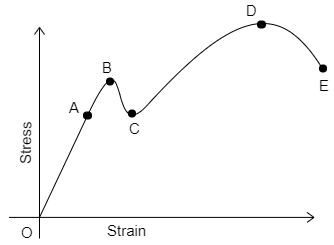
State Hooke’s law. Hence draw a typical stress-strain curve for a metallic wire and label the parts.
Answer
568.2k+ views
Hint
Hooke’s law shows that the force needed to the material to expand or compress by some distance. The stress and strain diagram shows that the behaviour of the material under the gradual increase of the load. The stress and diagram can be drawn for all the material, to know its behaviour under different load conditions.
Complete step by step answer
Hooke’s law:
Hooke’s law states that for relatively small deformation of the object, the displacement of the deformation is directly proportional to the force applied to the object.
$\Rightarrow F = kX$
Where, $F$ is the force applied to the object, $k$ is the spring constant for the object and $X$ is the spring stretch or compression.
The Stress vs Strain graph for the metallic wire is:

From the stress and strain curve,
1. The line OA is the proportional limit, which means that the stress is directly proportional to the strain. And the material behaves like rubber, which means after the removal of the load the material comes to the original shape. There is no change in the shape and size of the material of the metallic wire.
2. The point B is the upper yield point, which means that the material can withstand and does not undergo the deformation until this point. So, the point B is the maximum stress that the metallic wire doesn’t undergo deformation.
3. The point C is the lower yield point, which means to maintain the plastic behaviour of the material. After the point B, the material changes to the plastic deformation. To maintain the plastic behaviour the point C is required.
4. The point D is the Ultimate stress point; it is the peak point in the stress and strain graph. At this point the material reaches the maximum plastic behaviour limit. After this point very several force only the material with stand.
5. The point E is the breaking point, where the material breaks into two or more parts.
Note
The ratio of the stress and the strain is called Young’s modulus. So, this graph is also known as the Young’s modulus graph of the metallic wire. When load is applied to the material, first it acts like elastic material up to some limit, after that limit it converts to the plastic behaviour on further it will break.
Hooke’s law shows that the force needed to the material to expand or compress by some distance. The stress and strain diagram shows that the behaviour of the material under the gradual increase of the load. The stress and diagram can be drawn for all the material, to know its behaviour under different load conditions.
Complete step by step answer
Hooke’s law:
Hooke’s law states that for relatively small deformation of the object, the displacement of the deformation is directly proportional to the force applied to the object.
$\Rightarrow F = kX$
Where, $F$ is the force applied to the object, $k$ is the spring constant for the object and $X$ is the spring stretch or compression.
The Stress vs Strain graph for the metallic wire is:

From the stress and strain curve,
1. The line OA is the proportional limit, which means that the stress is directly proportional to the strain. And the material behaves like rubber, which means after the removal of the load the material comes to the original shape. There is no change in the shape and size of the material of the metallic wire.
2. The point B is the upper yield point, which means that the material can withstand and does not undergo the deformation until this point. So, the point B is the maximum stress that the metallic wire doesn’t undergo deformation.
3. The point C is the lower yield point, which means to maintain the plastic behaviour of the material. After the point B, the material changes to the plastic deformation. To maintain the plastic behaviour the point C is required.
4. The point D is the Ultimate stress point; it is the peak point in the stress and strain graph. At this point the material reaches the maximum plastic behaviour limit. After this point very several force only the material with stand.
5. The point E is the breaking point, where the material breaks into two or more parts.
Note
The ratio of the stress and the strain is called Young’s modulus. So, this graph is also known as the Young’s modulus graph of the metallic wire. When load is applied to the material, first it acts like elastic material up to some limit, after that limit it converts to the plastic behaviour on further it will break.
Recently Updated Pages
Why are manures considered better than fertilizers class 11 biology CBSE

Find the coordinates of the midpoint of the line segment class 11 maths CBSE

Distinguish between static friction limiting friction class 11 physics CBSE

The Chairman of the constituent Assembly was A Jawaharlal class 11 social science CBSE

The first National Commission on Labour NCL submitted class 11 social science CBSE

Number of all subshell of n + l 7 is A 4 B 5 C 6 D class 11 chemistry CBSE

Trending doubts
Differentiate between an exothermic and an endothermic class 11 chemistry CBSE

10 examples of friction in our daily life

One Metric ton is equal to kg A 10000 B 1000 C 100 class 11 physics CBSE

Difference Between Prokaryotic Cells and Eukaryotic Cells

1 Quintal is equal to a 110 kg b 10 kg c 100kg d 1000 class 11 physics CBSE

State the laws of reflection of light




